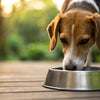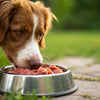Understanding How Many Pounds of Raw Food Should a Dog Eat
- Houndsy
Table of Contents
- Introduction
- The Basics of Canine Nutrition
- How Many Pounds of Raw Food Should a Dog Eat?
- Factors Influencing Feeding Amounts
- The Transition Period
- Conclusion
Introduction
Did you know that the right amount of food can significantly influence your dog's health, energy levels, and overall well-being? While many pet owners approach their dog's diet with love and intention, the specifics surrounding how much food to feed can sometimes feel confusing. This uncertainty is especially true when considering the growing popularity of raw dog food diets, which promise enhanced vitality and improved health.
In this blog post, we will explore the essential guidelines that dictate how many pounds of raw food a dog should eat. We aim to empower you as a pet parent to make informed decisions about your dog’s nutrition by providing insights into various factors that influence dietary needs, including age, activity level, and health status. Additionally, we'll shed light on the benefits and challenges of transitioning to a raw food diet. By the end, you will have clarity on determining the right amount of raw food for your furry friend, ensuring a balanced and healthy diet.
Let's embark on this journey to elevate our understanding of canine nutrition, together!
The Basics of Canine Nutrition
Understanding Raw Food Diets
Before we delve into the specifics of how much raw food to feed your dog, it’s essential to understand what a raw food diet entails. Generally, a raw food diet consists of raw meat, bones, organs, and, in some cases, fruits and vegetables. This diet is believed to mimic what canines would naturally eat in the wild, purportedly leading to improved digestion, healthier skin, and shinier coats.
Nutritional Needs of Dogs
Dogs have unique nutritional requirements, and their dietary needs vary based on several factors, such as:
- Age: Puppies, adults, and senior dogs have different nutritional needs.
- Activity Level: Active dogs require more calories and nutrients compared to their sedentary counterparts.
- Health Status: Dogs with specific health conditions may need specialized diets to manage their weight and nutritional intake.
- Breed: Different breeds have varying energy levels and nutritional requirements.
The Importance of Calculating Food Portions
Tailoring your dog's diet to their specific needs can prevent weight issues, ensure adequate nutrition, and promote optimal health. An accurate feeding routine can be a game-changer, especially for owners transitioning from standard kibble to raw diets.
How Many Pounds of Raw Food Should a Dog Eat?
General Guidelines for Raw Feeding
The common recommendation for feeding dogs raw food is to offer between 2% to 3% of their ideal body weight. However, the range can shift based on factors such as age and daily activity levels:
- Inactive or Obese Dogs: Aim for 2%.
- Average Activity Level: Feed about 2.5% to 3%.
- Highly Active Dogs: Up to 4% or even 5% might be necessary for performance or working dogs.
Example Calculations
Let's consider an example of feeding a 50-pound dog:
- 2% of body weight: 50 lbs x 0.02 = 1 lb daily
- 3% of body weight: 50 lbs x 0.03 = 1.5 lbs daily
- 4% of body weight: 50 lbs x 0.04 = 2 lbs daily
This means that a 50-pound dog could be fed anywhere from 1 to 2 pounds of raw food per day, depending on their activity level and dietary needs.
Feeding Charts
To give you a clearer picture, here’s a breakdown of suggested raw food portions based on dog weight:
| Dog Weight | 2% | 3% | 4% |
|---|---|---|---|
| 10 lbs | 0.2 lbs (3.2 oz) | 0.3 lbs (4.8 oz) | 0.4 lbs (6.4 oz) |
| 25 lbs | 0.5 lbs (8 oz) | 0.75 lbs (12 oz) | 1 lbs (16 oz) |
| 50 lbs | 1 lbs (16 oz) | 1.5 lbs (24 oz) | 2 lbs (32 oz) |
| 75 lbs | 1.5 lbs (24 oz) | 2.25 lbs (36 oz) | 3 lbs (48 oz) |
| 100 lbs | 2 lbs (32 oz) | 3 lbs (48 oz) | 4 lbs (64 oz) |
Feeding Puppies
Puppies require significantly more nutrition to support their growth and development. The general guideline is to feed them 4% to 6% of their current body weight, divided into multiple meals throughout the day. For example:
- A 10-pound puppy may require 0.4 to 0.6 lbs of raw food daily, typically split into 3-4 meals.
It’s essential to monitor their weight and adjust food portions accordingly while ensuring they don’t experience rapid weight gain or loss.
Health Monitoring
Transitioning to raw diets can prompt changes in your dog’s weight, shedding light on their true nutritional needs. Observing factors such as energy levels, coat condition, and waste production can guide you in fine-tuning their diet over time. A valuable strategy is to consult with your veterinarian regularly, especially when making changes to your dog’s diet.
Factors Influencing Feeding Amounts
Activity Level
The more active your dog is, the more calories they will require. For example, if you have an energetic dog who loves long walks or agility courses, they may need towards the higher end of the percentage scale for their weight—between 4% and 5%.
Age and Life Stages
Puppies, adults, and senior dogs have different caloric requirements. Puppies may necessitate a higher food intake per pound of body weight to support growth, while older dogs might need fewer calories to maintain a healthy weight.
Weight Management
Dogs on a weight-loss regimen should be fed at the lower end of the scale—closer to 2% of their body weight. Monitoring their weight is crucial during this time to ensure a gradual and healthy weight loss. Keep in mind that significant weight fluctuations should be discussed with your veterinarian.
The Transition Period
Moving to a Raw Food Diet
Transitioning your dog from commercial kibble to a raw food diet should be done gradually to avoid digestive upset. Here are some steps to ensure a smooth transition:
- Start Slow: Introduce raw food gradually over a week or two, replacing a portion of their regular food.
- Monitor Digestive Health: Keep an eye on their waste and overall health, adjusting food amounts as necessary.
- Consult Your Veterinarian: A professional can provide tailored advice and may recommend specific food types that suit your dog best.
The Houndsy Kibble Dispenser
As you embark on this feeding journey, consider how the Houndsy Kibble Dispenser can simplify your feeding routine. Our innovative design offers perfect portion control, ensuring you can easily meet your dog's nutritional needs while enhancing your home decor. For more details, check out the Houndsy Kibble Dispenser.
Frequently Asked Questions
How long should I transition my dog to a raw food diet?
A gradual transition over a week or two is generally recommended to allow your dog's digestive system to adjust comfortably.
What are the risks of a raw food diet?
Feeding raw food can pose risks regarding bacterial exposure and nutritional deficiencies if not balanced correctly. It's crucial to follow guidelines and work closely with your veterinarian.
Can I mix raw food with kibble?
Most experts recommend separating raw food and kibble, as they digest at different rates. For best practice, consider feeding them at different times of the day.
How can I ensure my dog's raw food is balanced?
Consult with your veterinarian or a pet nutritionist to evaluate and formulate a balanced meal plan tailored to your dog's needs, taking into account the various sources of nutrition.
How much raw food should I feed my dog after switching from kibble?
Follow the percentage guidelines (2% to 4%, depending on activity levels) based on your dog's current weight and adjust as needed during the transition.
Conclusion
Determining how many pounds of raw food your dog should eat is a journey that involves understanding their unique needs and lifestyle. By considering factors such as age, activity level, health status, and transitioning carefully to a raw diet, we can ensure our dogs thrive on wholesome nutrition.
As we embrace this new feeding approach, let’s remember that our choices deeply impact our furry friends’ health and happiness. If you're looking for a way to elevate your pet feeding experience, the Houndsy Kibble Dispenser can help streamline your routine and make meal times a delightful affair. Learn more about the Houndsy Kibble Dispenser and give your pup the nourishment they deserve!












